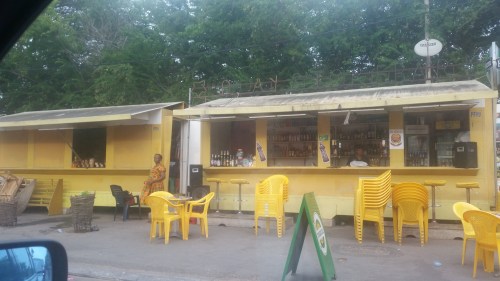Lomé, Togo perhaps does not have the reputation of an incredible, not to miss tourist spot. On the surface, that might seem strange, as it does have a lot going for it – after all, who wouldn’t like to visit a capital city where the sun eternally shines over yellow sand beaches dotted with the palm trees and small wooden fishing boats, where the Atlantic Ocean (Gulf of Guinea) brings a welcome breeze to enliven the almost eternally hot air (the yearly mean temperature is a moderate 75 degrees)?

The unfortunate truth is that cozy hotel restaurants with well-kept, clean patios and calm waves like the one in the photo above are the exception rather than the rule. Togo is one of the smallest and poorest countries in Africa, and with a yearly annual income of $1,500 per inhabitant, it is the 12th poorest country in the world. The economy is precariously dependent on agriculture (coffee, cocoa beans, peanuts, cassava and millet) and mining – phosphate, one of Togo’s natural riches, is a main export. Tourism is virtually unknown – as you will soon realize if you are trying to prepare for a trip there.
That said, if you find yourself in Lomé for a few days, there are certainly things to do and places to explore.
- Lomé Grand Market is in the center of the city. It’s hard to tell where it starts and where it ends. It seems to be divided by specialty, with certain streets dedicated to selling certain wares – everything from fresh fruits to socks to carved wooden masks and colorful shirts. This is probably the best place to buy a souvenir (although if you are searching for postcards, you are on a hopeless quest. I advise a magnet or wooden box instead).

One of the ‘artisan’ streets.

2. Fabric stores can be fascinating places if you like bold colors and exciting patterns. Our tour guide told us that each pattern has a different meaning or name and is used to show the social status of the wearer. A typical engagement gift for a woman should contain not only a few rings, but also 12 swathes of expensive fabric that the woman has made into dresses that she proudly wears (sure puts our one measly diamond ring to shame!). If you have time, I’d recommend going to these stores early on during your trip so you can have a local seamstress convert your fabric into a beautiful dress. (One interesting note: while the textiles are popular all over West Africa, apparently the best quality and most famous ones are produced in the Netherlands and exported to Togo!)
3. Lomé Cathedral – The Sacred Heart Cathedral is just a little over 100 years old and a fine example of colonial architecture. Its distinct white walls with red brick piping and green roofs tower over a sea of sun umbrellas from the streets surrounding it.
4. Monument de l’Independance is a landmark, however it is the middle of a ring of government buildings including the parliament, hence it is difficult to access. It is nicely designed and the grounds surrounding it are beautiful – but closed off to the public with a large fence.

I had to satisfy myself with the view from the hotel (gym, no less).
5. Restaurants in Lomé. Most are attached to hotels, but all give a good introduction to Togolese and West African cuisine. I especially enjoyed my meal at Cote Jardin with its open air feel, the cheery decorations and the chatty parrot, but the idyllic ambiance at Coco Beach Togo with the soothing ocean waves and sand under my feet was the real winner.
The seafood was also delicious – although in the interest of full disclosure, it was also likely the cause of the stomach bug which made my next week decidedly less than idyllic (an inescapable companion of international travel, I’ve found). Finally, for more local flavor, we enjoyed a typical meal at Ely Resto on Bd du Mono – fufu (peeled and boiled yams beaten into the consistency of homemade playdough) which was served with a variety of rich, spicy sauces (okra and tomato was my favorite). You are given a bowl and pitcher of water to wash your hands in case you wish to partake in the traditional way (scooping up the sauce with the fufu in your hand), or a fork and spoon if you prefer.
Hotels also have good eateries and bars: especially to be recommended is the Hotel 2 Fevrier with its poolside bar (also boasting the only escalator in the country, cordoned off and used mostly for selfie purposes) and the hotel Sarakawa right by the beach.
Just be prepared to wave off flies, wherever you are.
6. Or, you can always stop by a roadside bar to get a glass of sodabi.

Legend has it that back in the day, a disbelieving British man who didn’t think that the locals were capable of producing a gin-like drink was given a glass of the local palm wine liquour and exclaimed “So that be” = sodabi.
You’ll notice that I left off this list the Fetish Market. This is because I really and truly believe you are better off not visiting the place. I’ll explain in a following post, but for now, just trust me.
It’s true that Lomé is perhaps not the most exciting city in the world, and the poverty of the population is depressingly apparent, from families sleeping on the beach without even the protection of a cardboard box, to skinny kids with protruding bellies dragged their feet on the side of the dusty road.
But there is definitely enough to do and see and experience for a day or two, enough to get a small taste of Togolese culture and life, unlike anything I’d ever seen before.




